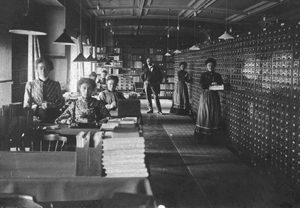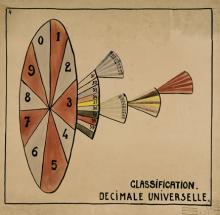UDC History
In 1885, Paul Otlet, a young Belgian barrister already noted for his work in documentation and his
collaborator Henry La Fontaine
were working on the projected Universal Bibliographic Repertory,
 which was intended to become a comprehensive classified index to all published information.
A means of arranging
the entries would be needed, and Otlet, having heard of Dewey’s Decimal Classification wrote to Melvil Dewey in 1895 and obtained
permission to translate it into French.
which was intended to become a comprehensive classified index to all published information.
A means of arranging
the entries would be needed, and Otlet, having heard of Dewey’s Decimal Classification wrote to Melvil Dewey in 1895 and obtained
permission to translate it into French.
The first analytico-synthetic classification
Otlet and La Fontaine saw in Decimal Classification a taxonomy of human knowledge that could be expressed (as they
said in a conference paper) ‘in an international language - that of numbers’; they saw too that, because of the
extensibility of decimal numbers, it could readily accommodate the detail needed for bibliographic rather than
strictly library use.
 The idea outgrew the plan of mere translation, and a number of radical innovations were made,
adapting the purely enumerative classification (in which all the subjects envisaged are already listed and coded)
into one which allows for synthesis (that is, the construction of compound numbers to denote interrelated subjects
that could never be exhaustively foreseen); various possible relations between subjects were identified, and
symbols assigned to represent them.
They also realized that characteristics common to many subjects could be assembled
as a separate list; repeated patterns of digits where the same characteristic of division was applied were already
present to some extent in Dewey’s first edition, but now the further step was taken of detaching the terminal digits
and listing them as tables of auxiliary numbers, which could be added as required by the user. This synthetic
principle meant that a level of detail could be obtained much greater than what was actually displayed in the published
scheme: higher precision combined with economy of presentation. At the same time, Otlet and La Fontaine were
expanding the purely enumerative content, to provide for the extensive requirements of the Repertory, and the result
was a scheme both more copious and more sophisticated than its predecessor.
The idea outgrew the plan of mere translation, and a number of radical innovations were made,
adapting the purely enumerative classification (in which all the subjects envisaged are already listed and coded)
into one which allows for synthesis (that is, the construction of compound numbers to denote interrelated subjects
that could never be exhaustively foreseen); various possible relations between subjects were identified, and
symbols assigned to represent them.
They also realized that characteristics common to many subjects could be assembled
as a separate list; repeated patterns of digits where the same characteristic of division was applied were already
present to some extent in Dewey’s first edition, but now the further step was taken of detaching the terminal digits
and listing them as tables of auxiliary numbers, which could be added as required by the user. This synthetic
principle meant that a level of detail could be obtained much greater than what was actually displayed in the published
scheme: higher precision combined with economy of presentation. At the same time, Otlet and La Fontaine were
expanding the purely enumerative content, to provide for the extensive requirements of the Repertory, and the result
was a scheme both more copious and more sophisticated than its predecessor.
 It contained about 33,000 subdivisions.
It was published by the KB, in French, from 1902 to 1907, and was called the 'Handbook to the Universal Bibliographic
Repertory' (Manuel du Répertoire Bibliographique Universel). It was in fact the first edition of UDC.
It contained about 33,000 subdivisions.
It was published by the KB, in French, from 1902 to 1907, and was called the 'Handbook to the Universal Bibliographic
Repertory' (Manuel du Répertoire Bibliographique Universel). It was in fact the first edition of UDC.
UDC expansion
The scheme continued to expand, though interrupted by the First World War, and work progressed on a second edition, in which editorship was shared with Frits Donker Duyvis of the Dutch Patent Office, who was responsible for the extensive revision and expansion of the science and technology sections. It was published from 1927 to 1933, and by now had over 70,000 subdivisions. The Universal Bibliographic Repertory, the impetus for the scheme, was proving unmanageable, and this edition was now offered independently under the title 'Classification Decimale Universelle', the name by which (in various translations) it is still known. This edition became the master version of UDC, and remained so until 1993, when a new database became the authoritative source; from 1933 to 1993 the second French edition, as modified and augmented by approved amendments collected in various supplements and later in the serial Extensions and Corrections to the UDC, was the official source for all UDC editions. A third edition, the first in German, was next begun, under the editorship of Carl Walther, and published from 1934 to 1951; this was probably double the size of the second, about 140,000 subdivisions.Change of UDC ownership
The Institut International de Bibliographic (IIB) in 1931 became the Institut International de Documentation (IID), now with its headquarters at the Hague; in 1937 it changed to the Federation Internationale de Documentation (FID), and in 1988 changed again to the International Federation for Information and Documentation (FID), its name until the federation's dissolution in 2000. FID remained for many years the centre for the management and maintenance of UDC, and played a central role. In 1991, acting on the recommendations of the specially formed Task Force for UDC System Development, it held talks with several UDC publishers about restructuring the finance, management and maintenance of the scheme to ensure its future into the next century. As a result of these talks, the UDC Consortium (UDCC) was formed, with FID, BSI and four other publishers as founder members. All rights were transferred to the UDCC on 1 January 1992. Its first priority was the creation of a database of 60,000 entries, known as the Master Reference File (MRF), which was completed in the spring of 1993 and is now the authoritative statement of the content of UDC. The full editions (totalling about 220,000 entries) remain valid, and, as resources permit, extended sets of some classes to full edition level may be entered in the database. Since August 1949, authorized amendments have appeared in Extensions and Corrections to the UDC, issued at first six-monthly, later annually.
The working languages of FID were English, French and German, and these remained the medium for the maintenance and management of UDC (including all amendments appearing in Extensions and Corrections to the UDC) until 1992, when the UDCC took over. The official language of the Consortium is English.
Since the early editions, UDC has been translated into many other languages and is used in over hundred countries worldwide (c.f. "Bibliographical survey of UDC Editions", FID Publication 573. The Hague, FID, 1982; "UDC Translations: a survey report and bibliography" by A. Slavic. Extensions and Corrections to the UDC, 26 (2004).





